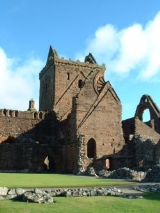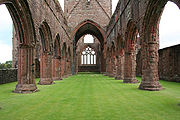
Sweetheart Abbey
Encyclopedia


Dumfries
Dumfries is a market town and former royal burgh within the Dumfries and Galloway council area of Scotland. It is near the mouth of the River Nith into the Solway Firth. Dumfries was the county town of the former county of Dumfriesshire. Dumfries is nicknamed Queen of the South...
, near to the Nith
River Nith
The River Nith is a river in South West Scotland.-Source, flow and mouth:The Nith rises in the Carsphairn hills of East Ayrshire, more precisely between Prickeny Hill and Enoch Hill, 7 km East of Dalmellington...
in south-west Scotland
Scotland
Scotland is a country that is part of the United Kingdom. Occupying the northern third of the island of Great Britain, it shares a border with England to the south and is bounded by the North Sea to the east, the Atlantic Ocean to the north and west, and the North Channel and Irish Sea to the...
, was a Cistercian monastery
Monastery
Monastery denotes the building, or complex of buildings, that houses a room reserved for prayer as well as the domestic quarters and workplace of monastics, whether monks or nuns, and whether living in community or alone .Monasteries may vary greatly in size – a small dwelling accommodating only...
, founded in 1275 by Dervorguilla of Galloway
Dervorguilla of Galloway
Dervorguilla of Galloway was a 'lady of substance' during the 13th century, wife from 1223 of John, 5th Baron de Balliol, and mother of the future king John I of Scotland. The name Dervorguilla or Devorgilla was a Latinization of the Gaelic Dearbhfhorghaill...
, daughter of Alan, Lord of Galloway
Alan, Lord of Galloway
Alan Fitz Roland was the last of the MacFergus dynasty of quasi-independent Lords of Galloway. He was also hereditary Constable of Scotland.-Family:He was the son of Roland, or Lochlann, Lord of Galloway and Helen de Morville...
, in memory of her husband John de Balliol. His embalmed heart
Heart
The heart is a myogenic muscular organ found in all animals with a circulatory system , that is responsible for pumping blood throughout the blood vessels by repeated, rhythmic contractions...
, in a casket of ivory
Ivory
Ivory is a term for dentine, which constitutes the bulk of the teeth and tusks of animals, when used as a material for art or manufacturing. Ivory has been important since ancient times for making a range of items, from ivory carvings to false teeth, fans, dominoes, joint tubes, piano keys and...
and silver
Silver
Silver is a metallic chemical element with the chemical symbol Ag and atomic number 47. A soft, white, lustrous transition metal, it has the highest electrical conductivity of any element and the highest thermal conductivity of any metal...
, was buried alongside her when she died - The monks at the Abbey then renamed the Abbey in tribute to her. Their son, also John, became king of Scotland but his reign was tragic and short. The depredations suffered by the Abbey in subsequent periods, have caused both the grave
Grave (burial)
A grave is a location where a dead body is buried. Graves are usually located in special areas set aside for the purpose of burial, such as graveyards or cemeteries....
s to be lost. The abbey
Abbey
An abbey is a Catholic monastery or convent, under the authority of an Abbot or an Abbess, who serves as the spiritual father or mother of the community.The term can also refer to an establishment which has long ceased to function as an abbey,...
, built in deep-red, local sandstone, was founded as a daughter house to Dundrennan Abbey
Dundrennan Abbey
Dundrennan Abbey, in Dundrennan, Scotland, near to Kirkcudbright, was a Cistercian monastery in the Romanesque architectural style, established in 1142 by Fergus of Galloway, King David I of Scotland , and monks from Rievaulx Abbey....
; this Novum Monasterium (New Monastery), became known as the New Abbey.
The immediate abbey precincts extended to 30 acres (121,405.8 m²) and sections of the surrounding wall can still be seen today. The Cistercian order, also known as the White Monks because of the white habit, over which they wore a black scapular
Scapular
The term scapular as used today refers to two specific, yet related, Christian Sacramentals, namely the monastic and devotional scapulars, although both forms may simply be referred to as "scapular"....
or apron, built many great abbeys after their establishment around 1100. Like many of their abbeys, the New Abbey's interests lay not only in prayer and contemplation but in the farming and commercial activity of the area, making it the centre of local life. The abbey ruins dominate the skyline today and one can only imagine how it and the monks would have dominated early medieval life as farmers, agriculturalists, horse and cattle breeders. Surrounded by rich and fertile grazing and arable land, they became increasingly expert and systematic in their farming and breeding methods. Like all Cistercian abbeys, they made their mark, not only on the religious life of the district but on the ways of local farmers and influenced agriculture in the surrounding areas.
The charming village which stands next to the ruins today, through time, also took the name and is now known as New Abbey
New Abbey
New Abbey is a village in Dumfries and Galloway, south-west Scotland. It is around south-west of Dumfries. The summit of the prominent hill Criffel is to the south....
. At the other end of the main street is Monksmill, a corn mill. Although the present buildings date from the late eighteenth century, there was an earlier mill built by and for the monks of the abbey which serviced the surrounding farms.
External links
- New Abbey from the Catholic EncyclopediaCatholic EncyclopediaThe Catholic Encyclopedia, also referred to as the Old Catholic Encyclopedia and the Original Catholic Encyclopedia, is an English-language encyclopedia published in the United States. The first volume appeared in March 1907 and the last three volumes appeared in 1912, followed by a master index...
See also
- Abbot of SweetheartAbbot of SweetheartThe Abbot of Sweetheart was the head of the Cistercian monastic community of Sweetheart Abbey, Dumfries and Galloway, founded by monks from Dundrennan Abbey with the patronage of Derbhfhorghaill inghean Ailein , Lady of Galloway, about 1275...
, for a list of abbots and commendators - List of places in Dumfries and Galloway

